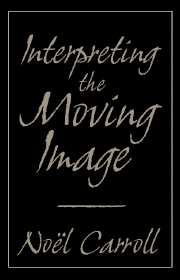Book contents
- Frontmatter
- Contents
- Foreword: Through Carroll's Looking Glass of Criticism
- Introduction
- 1 The Cabinet of Dr. Kracauer
- 2 Entr'acte, Paris and Dada
- 3 The Gold Rush
- 4 Keaton: Film Acting as Action
- 5 Buster Keaton, The General, and Visible Intelligibility
- 6 For God and Country
- 7 Lang, Pabst, and Sound
- 8 Notes on Dreyer's Vampyr
- 9 King Kong: Ape and Essence
- 10 Becky Sharp Takes Over
- 11 Interpreting Citizen Kane
- 12 The Moral Ecology of Melodrama: The Family Plot and Magnificent Obsession
- 13 Mind, Medium, and Metaphor in Harry Smith's Heaven and Earth Magic
- 14 Welles and Kafka
- 15 Nothing But a Man and The Cool World
- 16 Identity and Difference: From Ritual Symbolism to Condensation in Anger's Inauguration of the Pleasure Dome
- 17 Text of Light
- 18 Joan Jonas: Making the Image Visible
- 19 Introduction to Journeys from Berlin/1971
- 20 The Future of Allusion: Hollywood in the Seventies (and Beyond)
- 21 Back to Basics
- 22 Amy Taubin's Bag
- 23 Herzog, Presence, and Paradox
- 24 Film in the Age of Postmodernism
- Notes
- Index
4 - Keaton: Film Acting as Action
Published online by Cambridge University Press: 05 June 2012
- Frontmatter
- Contents
- Foreword: Through Carroll's Looking Glass of Criticism
- Introduction
- 1 The Cabinet of Dr. Kracauer
- 2 Entr'acte, Paris and Dada
- 3 The Gold Rush
- 4 Keaton: Film Acting as Action
- 5 Buster Keaton, The General, and Visible Intelligibility
- 6 For God and Country
- 7 Lang, Pabst, and Sound
- 8 Notes on Dreyer's Vampyr
- 9 King Kong: Ape and Essence
- 10 Becky Sharp Takes Over
- 11 Interpreting Citizen Kane
- 12 The Moral Ecology of Melodrama: The Family Plot and Magnificent Obsession
- 13 Mind, Medium, and Metaphor in Harry Smith's Heaven and Earth Magic
- 14 Welles and Kafka
- 15 Nothing But a Man and The Cool World
- 16 Identity and Difference: From Ritual Symbolism to Condensation in Anger's Inauguration of the Pleasure Dome
- 17 Text of Light
- 18 Joan Jonas: Making the Image Visible
- 19 Introduction to Journeys from Berlin/1971
- 20 The Future of Allusion: Hollywood in the Seventies (and Beyond)
- 21 Back to Basics
- 22 Amy Taubin's Bag
- 23 Herzog, Presence, and Paradox
- 24 Film in the Age of Postmodernism
- Notes
- Index
Summary
Introduction
Certain images unavoidably conjure up the idea of silent film: Chaplin in his derby; Lillian Gish swathed in mountains of curls; and of course, Buster Keaton with his deadpan intensity and his porkpie hat. In one sense, Keaton played a number of different roles; but, in another sense, these were merely surface variations of one underlying character, one underlying set of preoccupations which Keaton explored in different fictional guises. The purpose of this paper is to isolate the core structure of the Keaton character as found in his mature silent films.
When we think of “film acting” what comes first to mind, generally, are the pretenses, mannerisms, and implied motives that a performer employs to give substance to a certain fictional being. However, when applying the notion to Keaton, we must also bear in mind a much more basic sense of “acting,” viz., the sense of acting as being involved in a process of doing. Keaton's character, it could be said, is a product of a series of doings; his film acting, in a manner of speaking, is rooted in action. That is, in important respects, Keaton's character emerges not through declaiming, posturing, or emoting, but in the process of action, or better, in interactions, specifically with things. If such a rough distinction may be drawn, Keaton emphasizes the behavioral – the engagement with objects – rather than the psychological, where that category signals interest in the affective and in motivation.
- Type
- Chapter
- Information
- Interpreting the Moving Image , pp. 44 - 63Publisher: Cambridge University PressPrint publication year: 1998
- 2
- Cited by



